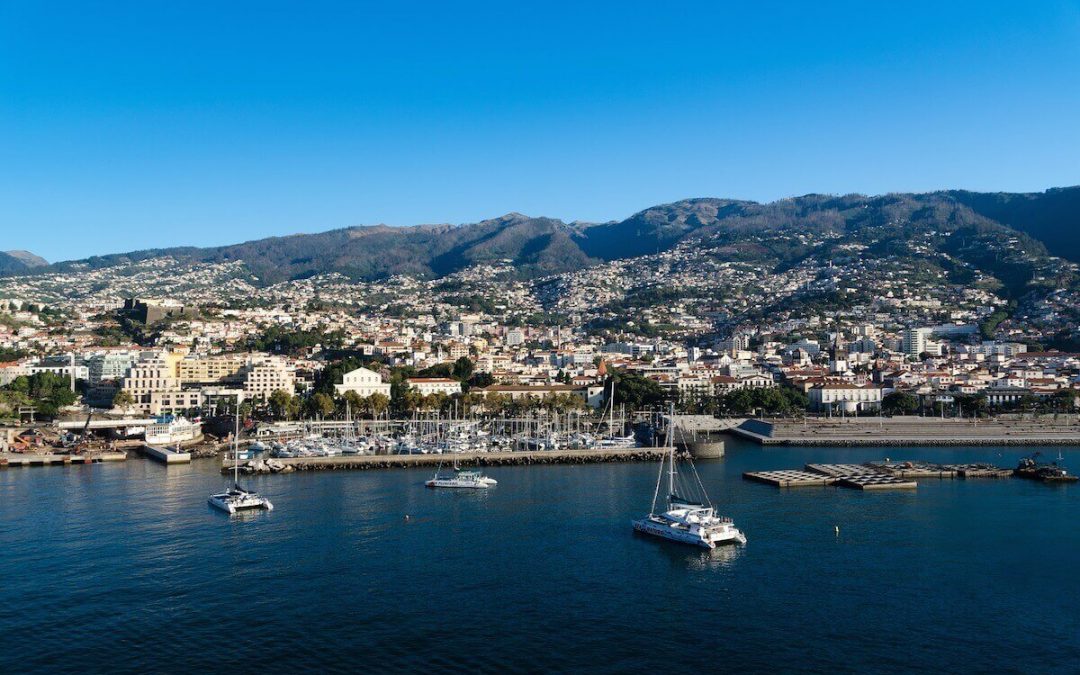Madeira Island is a Portuguese archipelago situated in the north Atlantic Ocean, southwest of Portugal. Its total population was estimated in 2011 at 267,785. The capital of Madeira is Funchal, located on the main island’s south coast.
Climate
Madeira Island has been classified as a Mediterranean climate. Based on differences in sun exposure, humidity, and annual mean temperature, there are clear variations between north- and south-facing regions, as well as between some islands. The islands are strongly influenced by the Gulf Stream and Canary Current, giving mild year-round temperatures; according to the Instituto de Meteorologia (IM), the average annual temperature at Funchal weather station is 19.6 °C (67.3 °F) for the 1980–2010 period. Porto Santo has at least one weather station with a semiarid climate (BSh). On the highest windward slopes of Madeira, rainfall exceeds 1,250 mm (50 inches) per year, mostly falling between October and April. In most winters snowfall occurs in the mountains of Madeira.
Levadas
The island of Madeira is wet in the northwest but dry in the southeast. In the 16th century the Portuguese started building levadas or aqueducts to carry water to the agricultural regions in the south. Madeira is very mountainous, and building the levadas was difficult and often sentenced criminals or slaves were used. Many are cut into the sides of mountains, and it was also necessary to dig 25 miles (40 km) of tunnels, some of which are still accessible.
Two of the most popular levadas to hike are the Levada do Caldeirão Verde and the Levada do Caldeirão do Inferno which should not be attempted by hikers prone to vertigo or without torches and helmets. The Levada do Caniçal is a much easier walk, running 7.1 miles (11.4 km) from Maroços to the Caniçal Tunnel. It is known as the mimosa levada because mimosa trees are found all along the route.
Tourism
Tourism is an important sector in the region’s economy since it contributes 20% to the region’s GDP, providing support throughout the year for commercial, transport and other activities and constituting a significant market for local products. The share in Gross Value Added of hotels and restaurants (9%) also highlights this phenomenon. The island of Porto Santo, with its 9 km (5.6 mi) long beach and its climate, is entirely devoted to tourism.
Cuisine
Because of the geographic situation of Madeira Island in the Atlantic Ocean, the island has an abundance of fish of various kinds. The species that are consumed the most are espada (black scabbardfish), blue fin tuna, white marlin, blue marlin, albacore, bigeye tuna, wahoo, spearfish, skipjack tuna and many others are found in the local dishes as they are found up and down the coast of Madeira. Espada is often served with banana. Bacalhau is also popular, as it is in Portugal.
Beverange
Madeira is a fortified wine, produced in the Madeira Islands; varieties may be sweet or dry. It has a history dating back to the Age of Exploration when Madeira was a standard port of call for ships heading to the New World or East Indies. To prevent the wine from spoiling, neutral grape spirits were added. However, wine producers of Madeira discovered, when an unsold shipment of wine returned to the islands after a round trip, that the flavour of the wine had been transformed by exposure to heat and movement. Today, Madeira is noted for its unique winemaking process which involves heating the wine and deliberately exposing the wine to some levels of oxidation. Most countries limit the use of the term Madeira to those wines that come from the Madeira Island, to which the European Union grants Protected Designation of Origin (PDO) status.

